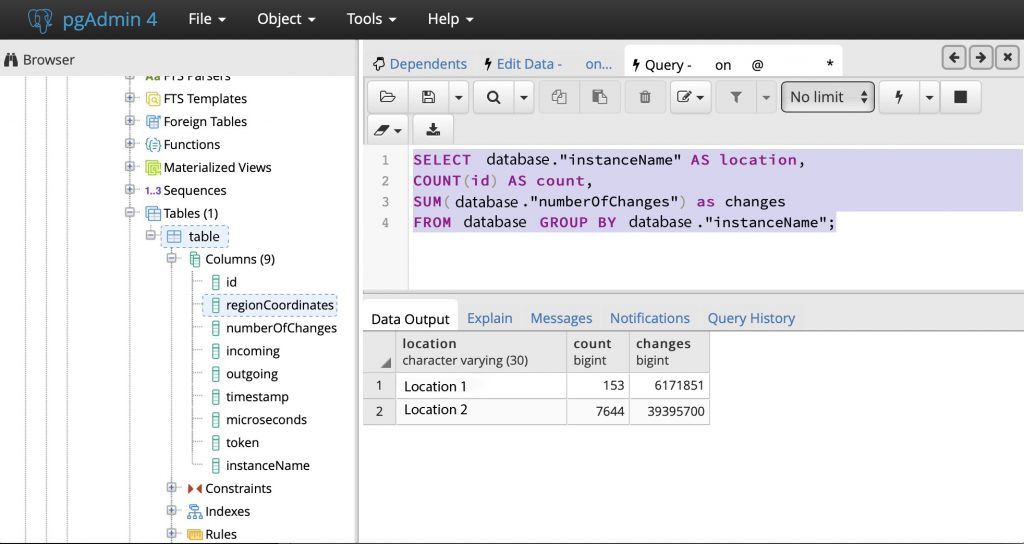

I suggest reading through the official documentation.Įdit: To make things simpler, I define the following alias in my ~/.psqlrc: \set whoami 'SELECT session_user, current_user, :''HOST'' host, :''PORT'' port, :''DBNAME'' dbname ’ Postgres authorisation is a complicated (arguably over-complicated) topic. It allows you to define users ( roles), groups and so on. This changes both current_user and session_user. PostgreSQL provides a highly sophisticated and powerful security and permission system. If you’re logged in as a superuser, you can change the authorisation profile for the entire session with: SET SESSION AUTHORIZATION To return to your default (session) role: RESET ROLE Note (2): Using SET ROLE changes only current_user and not session_user. Note (1): Superusers can SET ROLE to any other role without explicitly being granted access to it. … then myuser can temporarily “su” to postgres with: SET ROLE postgres

To change to another role to which you’ve been granted access: SET ROLE įor instance, if you’ve granted the postgres role to myuser with… GRANT postgres TO myuser Reset search_path to the global, cluster default which covers this topic in detail.To view your current authorisation: SELECT session_user, current_user Command History and Paging psql is a terminal application and as such it keeps a history of the queries and commands that you have executed. The simplest way for a DBA to get the value is to just look it up in nf. 1 2 pagiladev select from film pagiladev- The query will not be executed until the semicolon is added. pg_settings.boot_val won't do because it ignores changes in the configuration file, and pg_settings.reset_val won't either, because it's influenced by the database/user settings potentially set through ALTER USER/ALTER DATABASE. When it's set a non-default value in nf, it's not straightforward to obtain that value in SQL independently of the current session. The value of the setting prior to any change within the session (through the SET command) can be queried from the database with: SELECT reset_val FROM pg_settings WHERE name='search_path' The value of the setting prior to any change, including at the cluster level (through the global configuration nf) can be queried from the database with: SELECT boot_val FROM pg_settings WHERE name='search_path' To get at the values that are configured aside from these commands: Only settings passed to ALTER USER and ALTER DATABASE are present in this table. The permanent settings for both databases and roles are stored in the pg_db_role_settings system cluster-wide table.
#Postgres show user manual#
Use DDL commands as instructed in the manual for ALTER ROLE and ALTER DATABASE.Įssentially, the RESET command deletes a row from pg_db_role_setting allowing the base setting to take effect again. Never manipulate data in the system catalog ( pg_catalog.*) manually. Or: ALTER ROLE myrole in DATABASE mydb RESET search_path Or: ALTER DATABASE mydb RESET search_path To unset any settings of a role or database - the search_path in this particular example: ALTER ROLE myrole RESET search_path

How does the search_path influence identifier resolution and the “current schema” select currentuser The SQL command executed above is displayed in a real example below : roothostname psql -Upostgres -P psql (9.4.5) Type 'help' for help.If nothing is set, the next lower instance determines the default state of the search_path, which is nf in this case or command-line options at server start. WHERE r.rolname = 'myrole' OR d.datname = 'mydb' LEFT JOIN pg_database d ON d.oid = rs.setdatabase LEFT JOIN pg_roles r ON r.oid = rs.setrole This query retrieves any settings for a given role or database: SELECT r.rolname, d.datname, rs.setconfig You can find configuration settings for roles and databases in the catalog table pg_db_role_setting.


 0 kommentar(er)
0 kommentar(er)
